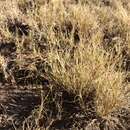Comprehensive Description
provided by North American Flora
Muhlenbergia repens (Presl) Hitchc. in Jepson, Fl. Calif. 1: 111. 1912.
Sporoholus repens Presl. Rel. Haenk. 1: 241. 1S30.
Vilfa repens Trin. Mem. Acad. St.-P6tersb. VI. 62; 102. 1840. (Ba,sed on Sporoholus repens Presl.)
Muhlenbergia subtilis Nees. Linnaea 19: 689. 1847. (Type from Mexico, Aschenborn Z06.)
Perennial, with widely creeping scaly rhizomes; culms decumbent, branching, spreading, the flowering branches 5-20 cm. long; sheaths glabrous; ligule rounded, 0.5-1 mm. long, broadly decurrent; blades mostly 1-2 cm. long, flat or soon involute, glabrous or nearly so beneath, scabrous-pubescent on the upper surface; panicles narrow, interrupted, 1-4 cm. long, the branches short, appressed, bearing 1-few spikelets; spikelets about 3 mm. long, the pedicels short, angled, scabrous; glumes half as long as the lemma or a little more, acutish, glabrous; lemma narrowed to a more or less apiculate summit, minutely roughened, usually darker than the glumes, the lateral nerves obscure; palea nearly as large as the lemma.
Type i.ocalit: Mexico (Haenke).
Distribution: Dry rocky or sandy open ground, Texas to Arizona; known in Mexico only from the type collection.
- bibliographic citation
- Albert Spear Hitchcock. 1935. (POALES); POACEAE (pars). North American flora. vol 17(6). New York Botanical Garden, New York, NY
Physical Description
provided by USDA PLANTS text
Perennials, Terrestrial, not aquatic, Rhizomes present, Rhizome elongate, creeping, stems distant, Stems nodes swollen or brittle, Stems geniculate, decumbent, or lax, sometimes rooting at nodes, Stems mat or turf forming, Stems solitary, Stems terete, round in cross section, or polygonal, Stem internodes hollow, Stems with inflorescence less than 1 m tall, Stems, culms, or scapes exceeding basal leaves, Leaves mostly cauline, Leaves conspicuously 2-ranked, distichous, Leaves sheathing at base, Leaf sheath mostly open, or loose, Leaf sheath smooth, glabrous, Leaf sheath and blade differentiated, Leaf blades linear, Leaf blades very narrow or filiform, less than 2 mm wide, Leaf blade margins folded, involute, or conduplicate, Leaf blades mostly glabrous, Ligule present, Ligule an unfringed eciliate membrane, Inflorescence terminal, Inflorescence a contracted panicle, narrowly paniculate, branches appressed or ascending, Inflorescence a dense slender spike-like panicle or raceme, branches contracted, Inflorescence solitary, with 1 spike, fascicle, glomerule, head, or cluster per stem or culm, Inflorescence branches more than 10 to numerous, Flowers bisexual, Spikelets pedicellate, Spikelets laterally compressed, Spikelet less than 3 mm wide, Spikelets with 1 fertile floret, Spikelets solitary at rachis nodes, Spikelets all alike and fertille, Spikelets bisexual, Spikelets disarticulating above the glumes, glumes persistent, Spikelets disarticulating beneath or between the f lorets, Rachilla or pedicel glabrous, Glumes present, empty bracts, Glumes 2 clearly present, Glumes equal or subequal, Glumes shorter than adjacent lemma, Glumes awned, awn 1-5 mm or longer, Glumes 1 nerved, Lemmas thin, chartaceous, hyaline, cartilaginous, or membranous, Lemma similar in texture to glumes, Lemma 3 nerved, Lemma glabrous, Lemma apex acute or acuminate, Lemma awnless, Lemma mucronate, very shortly beaked or awned, less than 1-2 mm, Lemma margins thin, lying flat, Lemma straight, Callus or base of lemma evidently hairy, Callus hairs shorter than lemma, Palea present, well developed, Palea membranous, hyaline, Palea about equal to lemma, Palea 2 nerved or 2 keeled, Stamens 3, Styles 2-fid, deeply 2-branched, Stigmas 2, Fruit - caryopsis, Caryopsis ellipsoid, longitudinally grooved, hilum long-linear.

